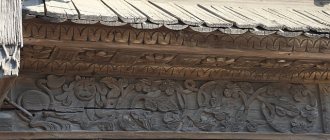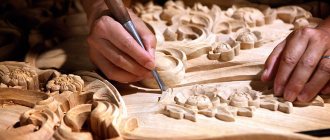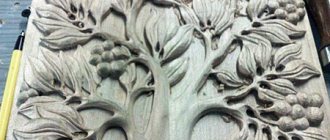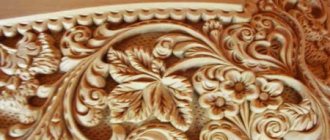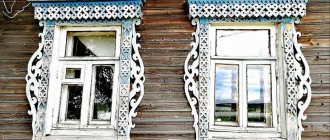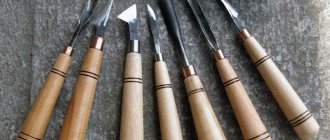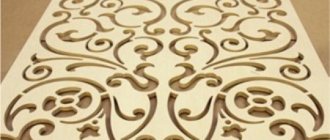In the old days in Rus', any village designer was guided by one main rule - “to be basque.” Beautiful, that is. Therefore, our ancestors generously decorated all the objects around them with all kinds of ornaments. Embroidery on fabric, painting on dishes, stone and wood carvings - each of these “decorations” carried both secret sacred and openly decorative meanings. Over the centuries, carvings alone in the Russian tradition have accumulated up to a dozen types. We invite you to remember the most interesting of them today.
Secret geometry
Spinning wheel leg. Vologda region, Tarnogsky district, Denisovskaya village. Master Stepan Ogloblin. 1890
Roller for beating clothes during washing. Zaonezhye. Late XIX - early XX century
Strand. Zaonezhye, Mezhvezhyegorsky district, Republic of Karelia
Geometric carving is the oldest design trend, known to mankind since pre-Christian times. Apart from a good eye and a confident hand, he did not demand anything from the master. Even a special tool: when applying the ornament, the carver could get by with an ordinary knife. As a rule, small objects were decorated with such carvings, which turned into a talisman. The fact is that the simplest patterns in the form of geometric shapes were symbols of elements and phenomena. By placing them in a certain order, the ancient masters tried to protect themselves from the forces of nature or, conversely, call on them for help. Such patterns were a kind of magic book for those who knew how to read them. A rosette with rays or just a circle called the grace of the Sun into the house. The cut diamonds were supposed to give the owner strength and power. A pattern of triangles applied to a primitive figurine of a horse was supposed to bring health to all livestock. Subsequently, rarely did any of the carvers use geometric carving according to pagan covenants - with the required number of spells and the number of swings of the knife. But objects decorated in this way can still be found in northern villages.
Elements of Russian folk painting
Red, black and gold are the three main colors, with yellow and green used as additional colors and in small quantities. Brushes are made from squirrel tails. It is this material that makes it possible to draw a thin line.
Products can be painted in two ways. The first method is to first paint the background completely with black paint, and apply a drawing on top. The second method is to first draw the outline of the ornament, only after that the background is painted over.
If you carefully look at the various works done in the Khokhloma style, you can identify several main patterns:
- Sedges. For this pattern, you need to lightly drag the tip of the brush from top to bottom.
- Blades of grass. The element looks like a small brush stroke with a smooth thickening.
- Droplets.
- Mustache.
- Curls.
- Bush. It was drawn using combinations of sedges, blades of grass, droplets, tendrils and curls. Moreover, the elements were always located symmetrically to each other.
- Berries. Mostly they painted lingonberries, currants, rowan berries, strawberries or gooseberries.
From the ship to the ball
Solid carving on the gate of Pavlova's house from the mid-19th century in the Museum of Wooden Architecture in Nizhny Novgorod. Photo by I. Bobylkova
Platbands and front plate with blind carvings on the house of the City of Masters complex in Gorodets, Nizhny Novgorod region
Solid carving of a bereginya (mermaid) on a cornice board and a lion on the front board of Pavlova’s house in the mid-19th century in the Museum of Wooden Architecture in Nizhny Novgorod. Photo by I. Bobylkova
Nizhny Novgorod blind carvings have perhaps the most interesting history. It migrated to houses directly from Mother Volga. This type of carving is also called “ship carving”, because it was used to decorate barks – ships on which a lot of goods were transported along the Volga. The barks have long been covered with the most bizarre, most skillful carvings. Researchers believe that this craving for beauty had the most practical justification.
Beginning in the late 1740s, a series of royal decrees prohibited the use of ax-hewn boards anywhere. The forest was then the main resource, it was protected and saved, because under the aspirations of Peter I, the forests around all major cities were mowed down almost to the skin. Carpenters are told to drop their axes and take up their saws. Since “from one log there can be five sawn boards, and at least four or three boards, and one rough board or, if necessary, two.” This could not please shipowners: it was believed that it was the ax board that was most suitable for shipbuilding. A strong blow seemed to seal the wood fibers, and such a board became invulnerable to water. And the sawn boards “wet” and “let in water.” However, because of the wrong building materials, one could end up not only under sanctions, but even under repression: fines, confiscation, whipping.
Manufacturing technology
At the very beginning, a wooden base was created. For the most part, these were household items: spoons, bowls, and so on. This base was called “linen”. After drying, the base is covered with specially purified clay and left to dry for 7-8 hours. During the drying process, the product is coated several times with flaxseed oil.
The next step is called "tinning". Aluminum powder is rubbed into the product with a special swab made from sheep leather. After this procedure, the object acquires shine and is ready for painting.
Wooden lace
Mezzanine of a house in Kostroma. End of the 19th century Photo by E.G. Shcheboleva.13 Mezzanine of a house dating back to the 19th century. Kostroma, st. Komsomolskaya, 18
Facade of the Agafurovs' house in Yekaterinburg. 1896–1897.14 Agafurov House, 1896-97. Ekaterinburg.
Decor of the mezzanine of a house in Myshkin, Yaroslavl region. Photo by E.G. Shchebolev.
But in the 19th century, when previously unknown thin factory-made boards appeared on the market, hands accustomed to axes nevertheless took up saws. Pre-designed patterns on a flat surface were sawed or drilled, turning wooden boards into a lace shawl. Flowers bloomed on the frames, stems intertwined on the shutters, the eye rejoiced, art critics winced. Of all types of wood carving, sawing was perhaps the most offended by the attention of serious researchers. Now it is difficult to understand what she did to deserve such disfavor. But the logic was this: during the heyday of factory capitalism, everything primordial and natural in peasant design suddenly became stereotyped and vulgar. Even in the thirties, when enthusiasts rushed to record and save examples of blind carvings from oblivion, magnificent saw-cut decorations were looked upon with contempt: no originality, they say, just a “disgusting bourgeois slot.” Ethnographers came to the defense: it took their thoughtful, many years of work to recognize this decorative option as having the right to be considered part of Russian national art.
Manufacturing technology
Before painting, the quality of the porcelain was checked. The product was dipped in magenta. Thus, the porcelain was painted pink, and the slightest cracks could be seen on it.
As a rule, craftsmen used cobalt-based paint. Before the product was fired, it was black. To work, the master needed only a brush and paint. But using various techniques, more than 20 shades of blue were created.
Curly patterns
State Historical, Artistic and Literary Museum-Reserve "Abramtsevo".
State Historical, Artistic and Literary Museum-Reserve "Abramtsevo".
State Historical, Artistic and Literary Museum-Reserve "Abramtsevo".
But what any critics have always been delighted with is the famous “curl”. Of course: this type of carving flourished under the patronage of recognized artists of the “Mamontov circle”, who set up a carpentry and carving workshop in Abramtsevo, the estate of the philanthropist Savva Mamontov. One of the students opened his own workshop in his village, Kudrin, where they worked on Abramtsevo orders. There the foundations of the new style were formed. Successfully coinciding with the then fashion for everything natively Russian, the new carving combined both ancient flat-relief and very ancient geometric. Branches, curls, rosettes, headpieces of early printed books, sketches by Elena Polenova, who studied in Paris and managed to add glamorous chic to ancient Russian ornaments - all this decorative wealth turned the “curl” into a noticeable phenomenon. Until now, this type of carving is considered one of the most popular in Russia and is included in the training standards for the training of professional wood carvers.
Technology
Trays were used for two purposes: for domestic use (as a stand for a samovar or for serving food) and as an element of the interior. The material for making the tray is ordinary sheet iron. The shape of the finished product can be any: round, rectangular, oval, etc. Before applying the pattern, the product goes through several important stages:
- Padding.
- Puttying.
- Grinding.
- Varnishing.
Thanks to this, the surface of the tray becomes perfectly flat. Oil paints are used for painting. At the end of the work, the product is coated with several layers of colorless varnish.
The painting itself was carried out in several stages:
- Stage 1. Background. At this stage, the main color is selected. It will be used as the background. Black was preferred, but white, red, blue, etc. could be used.
- Stage 2. Zamalenok. At this stage, the basis of the future pattern is made. Using diluted paint, the master applies the outlines of the future composition in accordance with his idea. After this, the trays are sent to dry in the oven for several hours.
- Stage 3. Tenezhka. At this stage, the artist, using translucent paints, applies shadows to the flowers. Thus making them voluminous.
- Stage 4. Gasket. This is the most critical stage. Now the master begins to clarify many details, highlight and implement a contrasting or more harmonious structure of his composition.
- Stage 5. Glare. At this stage, with the help of glare, light and more volume appear on the flower petals. Glare is needed to create mood and color.
- Stage 6. Drawing. This is the last stage of work on creating a bouquet. Using a very thin brush, the artist paints subtle veins on the leaves of the plant, a lacy edge on the leaves and seeds in the center of the flower.
- Stage 7. Binding. This stage is the penultimate stage in Zhostovo painting. The artist draws the thinnest stems, blades of grass and tendrils emanating from the bouquet itself. In this way, the master establishes a connection between the bouquet and the background.
- Stage 8. Cleaning. At this stage, the side of the tray is decorated. Typically a geometric or floral pattern is used for this purpose. The cleaning style depends on the desire of the master. It can be quite modest and consist of one repeating element, or it can be decorated richly and varied. If you skip this step, the product will look unfinished.
This way you can find endless variations of similar motifs. But you will never be able to find exact copies or repetitions.
Russian folk painting today
Even in the 21st century, painting does not lose its relevance. Painted products are not just part of the interior. Many of them have a wide functional load and are actively used in everyday life. For example, cutting food on a decorated cutting board or storing bread in a bread bin, which is painted by a master of his craft, are still relevant.
Painted products will add their own flavor to even a modest room, making it unique. But you shouldn’t overload your apartment with such things, as many of them look very bright. Two or three will be enough.
Also, different types of Russian folk painting are actively used to decorate walls, columns, borders and other interior elements. Such a solution looks great in a children's room or in the kitchen, as it will make the atmosphere brighter and more positive.
Story
Hints of Gorodets painting can be seen in the carved spinning wheels. In Gorodets they were unique in that the bottom (the place where the spinner sat) was decorated using a special technique. Wooden figurines carved from a different species were inserted into the recesses. Only two types of wood allowed Gorodets craftsmen to create stunning works of art. Later, touch-up paint was added to this.
In the second half of the 19th century, the demand for such products increased, which prompted craftsmen to abandon wood inlay as a complex technique and move on to simple pictorial elements.
Main stories
Nizhny Novgorod painting is divided into two types: Pavlovsk and Gorodets. They were used to decorate chests, arches, sleighs, and so on.
Gorodets Russian folk painting is distinguished by its content. Here you can see a variety of scenes. For the most part these were domestic situations. At the same time, most of the plot was devoted to floral motifs. You can also find birds and animals as the main characters of the painting. They can be both stylized and realistic. As a rule, the images were symmetrical, with animals or birds looking at each other.
This painting is characterized by the use of underpainting circles, spirals, drops, arcs, staples, strokes and dots. In this case, the last types of patterns are applied by the artist at the final stage in order to “revive” his work.
There are not many colors used in painting: red, green, blue and black. Images are applied to wood without preliminary drawing. The patterns are applied directly with a brush, and the artist can use both wide and free strokes and the finest strokes.
